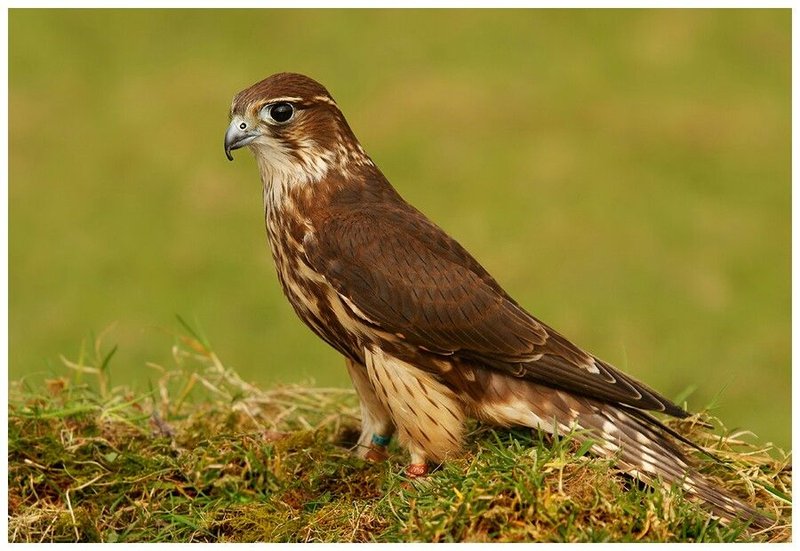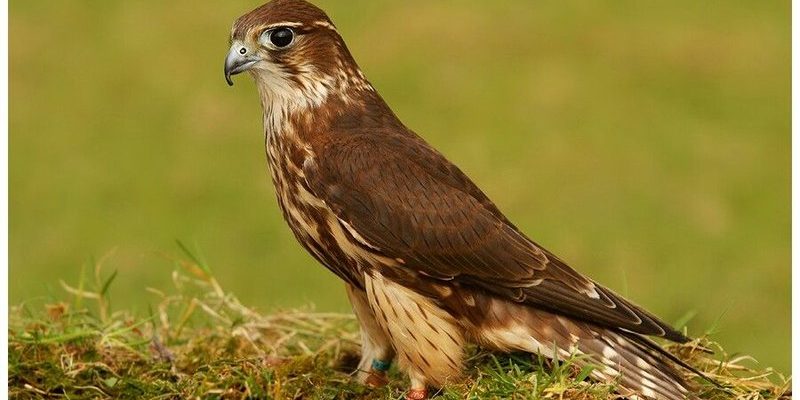
Imagine a bird that embodies speed and agility, a feathered athlete darting through the sky. That’s the Merlin for you! This small falcon is often overshadowed by larger birds of prey, but its remarkable hunting skills and stunning plumage make it quite a fascinating creature. Merlins are known for their fierce hunting techniques, often surprising their prey with rapid dives and swift maneuvers. If you’ve ever spotted one swooping down in a flash, you’re likely left in awe of its grace and speed.
Belonging to the falcon family, the Merlin is not just another bird. It’s a true marvel of nature, showcasing how evolution has perfectly honed its design for survival. They thrive in various habitats, from open fields to coastal regions, adapting well to different environments. With their striking appearance and captivating behavior, Merlins are a favorite among birdwatchers and nature enthusiasts alike. So, let’s dive deeper into the world of Merlins!
Physical Characteristics
One of the first things you’ll notice about the Merlin is its distinctive size and build. Unlike bigger raptors, Merlins are compact with a length of about 9 to 12 inches. They possess a wingspan ranging from 20 to 28 inches, making them agile fliers. What’s particularly interesting is their sexual dimorphism—female Merlins tend to be larger than males! The males are more colorful, featuring bluish-gray plumage, whereas females are more brownish and streaked, providing excellent camouflage.
Their sharp, hooked beaks are designed for tearing into flesh, perfectly suited for their predatory lifestyle. In addition to their striking appearance, Merlins have powerful talons that enable them to catch and hold onto their prey effectively. Their keen eyesight is just as impressive—these birds can spot movement from great distances. In this way, their physical traits are finely tuned for survival in the wild.
| Size: | 9 to 12 inches |
| Wingspan: | 20 to 28 inches |
| Diet: | Small birds, insects, and occasionally small mammals |
| Habitat: | Open fields, forests, coastlines |
| Speed: | Up to 40 mph while diving |
| Lifespan: | 5 to 10 years in the wild |
Habitat and Distribution
Merlins are not particular about their living spaces. They adapt well to various environments, which is one of the reasons they are widespread in North America, Europe, and parts of Asia. You might find them in open woodlands, moorlands, and even urban areas where they hunt for small birds. They enjoy places that provide plenty of perches to survey their surroundings, and they often build nests in shrubs or trees, using materials like twigs and grass.
During migration, Merlins can travel great distances. They are known to fly thousands of miles between their breeding and wintering grounds. Common migration routes bring them from as far north as the Arctic tundra down to warmer southern regions. This adaptability not only showcases their survival skills but also highlights their resilience against changing climates.
Diet and Hunting Techniques
When it comes to food, Merlins are expert hunters. Their diet mainly consists of small birds, which they catch mid-flight with astonishing speed. You might picture them soaring through the air and then suddenly diving like a missile to snatch their meal. They are not picky eaters, either; you’ll find them snacking on insects and occasionally small mammals. This diet is critical for their high-energy lifestyle, especially during breeding seasons when they need extra energy for raising chicks.
What’s fascinating is how they employ various hunting strategies. From relying on ambush tactics to using their incredible aerial skills, Merlins demonstrate impressive versatility. They often chase down other birds, even those larger than themselves, showcasing their bravery and skill. This relentless pursuit is what makes them so effective as hunters. If you’ve ever seen a Merlin zoom past, you’ll appreciate the sheer athleticism behind their flight.
Breeding and Nesting
Like many birds of prey, Merlins are monogamous during the breeding season. They typically mate for life, returning to the same nesting sites year after year. The breeding season usually occurs from late spring to early summer. Female Merlins are primarily responsible for incubating the eggs, while males take on the role of the primary provider. This division of labor ensures that both parents contribute to the growth and survival of their young.
The nest is often a simple structure, made of twigs, grass, and sometimes feathers. Females lay about 3 to 5 eggs, which hatch after about 30 days. The chicks are altricial, meaning they are born helpless and rely on their parents for care. As they grow, they learn essential flying skills and begin hunting with their parents. By the end of summer, these young Merlins are ready to strike out on their own, showcasing a remarkable journey from vulnerability to independence.
Merlins in Culture and Folklore
Throughout history, the Merlin has inspired countless tales and legends. In medieval times, noble households often prized Merlins for their hunting prowess, using them in falconry due to their agility and speed. They were symbols of nobility and grace, often associated with the art of hawking. The Merlin even finds its way into literature and folklore, captivating imaginations with stories of bravery and elegance.
Your love for nature might lead you to explore these cultural connections. Many societies view the Merlin as a positive omen, symbolizing freedom and swiftness. They are often depicted in art, literature, and even popular media as representations of strength and agility, reminding us of the wild spirit within.
Conservation Status
Despite their adaptability, Merlins face challenges in the wild. Habitat loss due to urbanization and agriculture poses significant threats. As open spaces shrink, their nesting areas and food supply diminish. Furthermore, climate change disrupts their migration patterns and breeding cycles, making it increasingly vital to monitor their populations.
Conservation efforts focused on protecting their habitats have become essential. Organizations and wildlife enthusiasts work tirelessly to promote awareness and create safe spaces for these magnificent birds. Being vigilant about conservation can ensure that future generations can enjoy seeing Merlins soar through the skies, maintaining the balance of our ecosystems.
FAQ
What is the lifespan of a Merlin in the wild?
In the wild, a Merlin typically lives around 5 to 10 years. However, various factors such as environmental conditions, availability of food, and predation can influence their lifespan. Some individuals may live longer under optimal circumstances, especially when protected from threats.
Are Merlins aggressive towards humans?
Merlins are generally not aggressive towards humans. They might show some defensive behavior during nesting seasons, but they typically avoid confrontations. In fact, they are more likely to flee than confront a human, preferring to keep their distance.
How can I attract Merlins to my backyard?
Attracting Merlins to your backyard can be a bit challenging, as they prefer open spaces to hunt. However, you can create a suitable environment by providing perches, such as tall trees or poles, where they can survey their surroundings. Offering a habitat that attracts smaller birds, which are part of their diet, can also help draw them in.
Do Merlins migrate?
Yes, Merlins are migratory birds. They typically migrate from their breeding grounds in the north to warmer southern regions during the fall months. This migration can cover thousands of miles, showcasing their impressive endurance and adaptability.
What sounds do Merlins make?
Merlins produce a variety of sounds, including sharp calls and whistles. During the breeding season, you might hear their distinctive “kak-kak-kak” or “chip-chip” calls, which signal their presence to other Merlins or potential threats. These vocalizations play an essential role in communication.
Can Merlins be kept as pets?
Keeping a Merlin as a pet is not feasible or advisable for most people. They are wild birds with specific needs for space, diet, and social interaction. Additionally, many countries have strict laws regarding the ownership of birds of prey. Instead, consider supporting conservation efforts to protect these beautiful creatures in their natural habitat.
What do young Merlins look like?
Young Merlins, or fledglings, initially have a more mottled appearance compared to adults. Their plumage is generally browner with streaks, providing camouflage as they learn to hunt. As they mature, they gradually develop the striking colors associated with adult Merlins, with males becoming more vibrant.
How do Merlins hunt?
Merlins are skilled hunters, using a combination of speed and agility to catch small birds mid-flight. They often rely on ambush tactics, perching high in trees or on posts, then swooping down quickly to catch their prey. This hunting strategy showcases their exceptional aerial skills and keen eyesight.
Are Merlins social birds?
Merlins are generally solitary outside of the breeding season. They may be seen in loose groups during migration but tend to hunt and nest alone. However, they do exhibit some social behaviors during breeding, where pairs can be seen cooperating in care for their young.
What is the best time to see Merlins?
The best time to observe Merlins is during migration, typically in the fall and spring, when they are most active. During these times, they can often be spotted hunting or perched in open areas. Additionally, early mornings or late afternoons are usually the most fruitful for birdwatchers aiming to catch a glimpse of these agile falcons.

